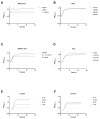A Cryptic Non-Inducible Prophage Confers Phage-Immunity on the Streptococcus thermophilus M17PTZA496
- PMID: 30583530
- PMCID: PMC6356513
- DOI: 10.3390/v11010007
A Cryptic Non-Inducible Prophage Confers Phage-Immunity on the Streptococcus thermophilus M17PTZA496
Abstract
Streptococcus thermophilus is considered one of the most important species for the dairy industry. Due to their diffusion in dairy environments, bacteriophages can represent a threat to this widely used bacterial species. Despite the presence of a CRISPR-Cas system in the S. thermophilus genome, some lysogenic strains harbor cryptic prophages that can increase the phage-host resistance defense. This characteristic was identified in the dairy strain S. thermophilus M17PTZA496, which contains two integrated prophages 51.8 and 28.3 Kb long, respectively. In the present study, defense mechanisms, such as a lipoprotein-encoding gene and Siphovirus Gp157, the last associated to the presence of a noncoding viral DNA element, were identified in the prophage M17PTZA496 genome. The ability to overexpress genes involved in these defense mechanisms under specific stressful conditions, such as phage attack, has been demonstrated. Despite the addition of increasing amounts of Mitomycin C, M17PTZA496 was found to be non-inducible. However, the transcriptional activity of the phage terminase large subunit was detected in the presence of the antagonist phage vB_SthS-VA460 and of Mitomycin C. The discovery of an additional immune mechanism, associated with bacteriophage-insensitive strains, is of utmost importance, for technological applications and industrial processes. To our knowledge, this is the first study reporting the capability of a prophage integrated into the S. thermophilus genome expressing different phage defense mechanisms. Bacteriophages are widespread entities that constantly threaten starter cultures in the dairy industry. In cheese and yogurt manufacturing, the lysis of Streptococcus thermophilus cultures by viral attacks can lead to huge economic losses. Nowadays S. thermophilus is considered a well-stablished model organism for the study of natural adaptive immunity (CRISPR-Cas) against phage and plasmids, however, the identification of novel bacteriophage-resistance mechanisms, in this species, is strongly desirable. Here, we demonstrated that the presence of a non-inducible prophage confers phage-immunity to an S. thermophilus strain, by the presence of ltp and a viral noncoding region. S. thermophilus M17PTZA496 arises as an unconventional model to study phage resistance and potentially represents an alternative starter strain for dairy productions.
Keywords: Streptococcus thermophilus; bacteriophages; cryptic prophage; lipoprotein (Ltp); noncoding region.
Conflict of interest statement
The authors declare no conflict of interest.
Figures






Similar articles
-
Cell Wall Glycans Mediate Recognition of the Dairy Bacterium Streptococcus thermophilus by Bacteriophages.Appl Environ Microbiol. 2018 Nov 15;84(23):e01847-18. doi: 10.1128/AEM.01847-18. Print 2018 Dec 1. Appl Environ Microbiol. 2018. PMID: 30242010 Free PMC article.
-
Novel Variants of Streptococcus thermophilus Bacteriophages Are Indicative of Genetic Recombination among Phages from Different Bacterial Species.Appl Environ Microbiol. 2017 Feb 15;83(5):e02748-16. doi: 10.1128/AEM.02748-16. Print 2017 Mar 1. Appl Environ Microbiol. 2017. PMID: 28039135 Free PMC article.
-
The ltp gene of temperate Streptococcus thermophilus phage TP-J34 confers superinfection exclusion to Streptococcus thermophilus and Lactococcus lactis.Virology. 2006 Jun 20;350(1):146-57. doi: 10.1016/j.virol.2006.03.001. Epub 2006 Apr 27. Virology. 2006. PMID: 16643978
-
The endless battle between phages and CRISPR-Cas systems in Streptococcus thermophilus.Biochem Cell Biol. 2021 Aug;99(4):397-402. doi: 10.1139/bcb-2020-0593. Epub 2021 Feb 3. Biochem Cell Biol. 2021. PMID: 33534660 Review.
-
Genomic impact of CRISPR immunization against bacteriophages.Biochem Soc Trans. 2013 Dec;41(6):1383-91. doi: 10.1042/BST20130160. Biochem Soc Trans. 2013. PMID: 24256225 Review.
Cited by
-
Novel Genus of Phages Infecting Streptococcus thermophilus: Genomic and Morphological Characterization.Appl Environ Microbiol. 2020 Jun 17;86(13):e00227-20. doi: 10.1128/AEM.00227-20. Print 2020 Jun 17. Appl Environ Microbiol. 2020. PMID: 32303549 Free PMC article.
-
Bacteriophage-host interactions in Streptococcus thermophilus and their impact on co-evolutionary processes.FEMS Microbiol Rev. 2023 Jul 5;47(4):fuad032. doi: 10.1093/femsre/fuad032. FEMS Microbiol Rev. 2023. PMID: 37339909 Free PMC article. Review.
-
A Genome of Temperate Enterococcus Bacteriophage Placed in a Space of Pooled Viral Dark Matter Sequences.Viruses. 2023 Jan 12;15(1):216. doi: 10.3390/v15010216. Viruses. 2023. PMID: 36680256 Free PMC article.
-
Myriad applications of bacteriophages beyond phage therapy.PeerJ. 2023 Apr 21;11:e15272. doi: 10.7717/peerj.15272. eCollection 2023. PeerJ. 2023. PMID: 37101788 Free PMC article. Review.
-
Strengthening phage resistance of Streptococcus thermophilus by leveraging complementary defense systems.Nat Commun. 2025 Aug 4;16(1):7142. doi: 10.1038/s41467-025-62408-3. Nat Commun. 2025. PMID: 40759662 Free PMC article.
References
-
- Calasso M., Ercolini D., Mancini L., Stellato G., Minervini F., Di Cagno R., De Angelis M., Gobbetti M. Relationships among house, rind and core microbiotas during manufacture of traditional Italian cheeses at the same dairy plant. Food Microbiol. 2016;54:115–126. doi: 10.1016/j.fm.2015.10.008. - DOI
-
- Coton E., Leguerinel I. Encyclopedia of Food Microbiology. Elsevier; Amsterdam, The Netherlands: 2014. Ecology of Bacteria and Fungi in Foods | Effects of pH; pp. 577–586.
Publication types
MeSH terms
Substances
LinkOut - more resources
Full Text Sources

